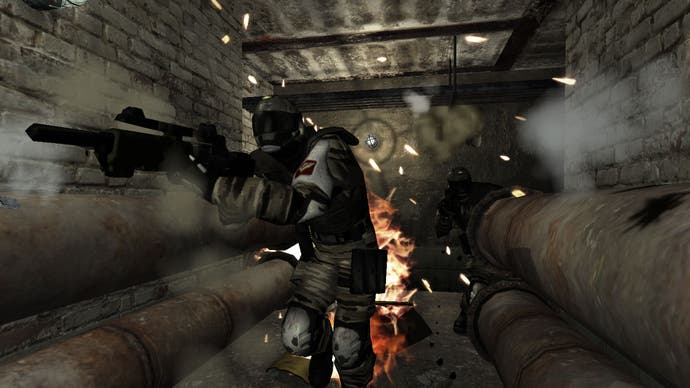The Double-A Team: F.E.A.R. is a state of mind
Scared for life.
F.E.A.R. was a game that gave the player military hardware with one hand, and a sense of terror with the other. As effective as the horror element remains today - including a number of admittedly cheap jump scares - what remains truly impressive 15 years after release is a side-effect. Arguably, no FPS before or since has offered the player such a powerful, transporting sense of place.
Horror is perhaps the genre most difficult to master in any medium. It demands a thunderous emotional response in order to be classed as successful which, in turn, requires an unchallenged suspension of disbelief. That emotional response needs to leap from a stable baseline, one that is in sync with one's day-to-day life. Here is a game that understood and, remarkably, even achieved that.
As you walk F.E.A.R.'s warehouses, stalk its streets, and creep along its corridors, you hear... almost nothing. It's unnervingly beautiful. Music is used sparingly throughout the game. It's ordinarily extremely subtle or - at the best moments - entirely absent. There are times that you'll receive a brief message over the radio, or you'll hear the telltale chatter of nearby enemies. Yet for much of the time - most in fact, or so it seems - it's just you and the bumps in the dark, real or imagined.
So much of the experience revels in the mundane. Even the audio log equivalents are answerphone messages, plausible tastes of people on the periphery. Although this was undoubtedly designed to draw a contrast with the hallucinatory moments, it cements the environment in the player's mentality. Despite the bodies and the blood, the supernatural and the shotguns, things are so normal. So relatable, so... real.

No discussion of F.E.A.R., in any context, is complete without exploring the enemy AI. It's little short of amazing that few - if any - games have learned lessons from it, as the system has much to teach. It provides the player with enemies more challenging and unpredictable than they're used to, that much is true. But an important side-effect is that this world, which already feels familiar and true, has been populated not by enemy soldiers - but by people.
Ordinarily, FPS enemies are translucent automatons, their inner workings on constant display. One's taken cover? No problem; hover your sight over the collection of pixels that you know, without a doubt, they will pop their head into momentarily. Snipers around? So what? You know exactly where they'll be and what they'll do. And so on. But here? In this world? Enemy soldiers, despite their homogenous appearance, are unlike those you're used to. Start shooting them, and they'll run away - just like you would. Throw a grenade, they'll run for cover - just like you would. If they feel outgunned, they'll be cautious - just like you would. They'll try to flank you, try to outsmart you. They act as though they don't want to die. They have something that the enemies in a thousand other games will never have.
They have life.
Too often, a game's atmosphere is shattered whenever unthinking enemies make an appearance. That's no issue here, and so the enemy ranks reinforce rather than undermine the sense of reality. The fantastical moments therefore sweep you up without resistance, getting your heart pumping while faced with a monster or a vision before swiftly dropping you back into reality; likely into another extended period of quiet where very little happens. How very strange that a supernatural horror shooter should prove to be more realistic than any military game on the market.









